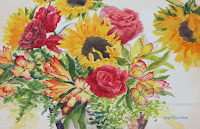Watercolor Project: TJs Bouquet Week 3
I hope that everyone has been working on their
flowers so that this week you can start putting in the background. This dark
background is what will make these flowers pop, you so you will see dramatic
changes once you start putting in your background.
You will need to have your reference photo in
front of you to paint this background. There will be a lot of negative painting
so you will need to see where it is so you can leave unpainted areas when you
get to them. You also need to choose a background color for the area you
painting, I don't care what color it is, I chose a blue/green, though it will
eventually get dark as it goes to the corners. Have a color near the flowers
that will compliment to the colors of the bouquet. There are yellows and reds and
greens so you can choose those colors that are the complementary colors too red
green and yellow, you could choose a color that will fit into the color of the
room you might hang the finished painting, but remember it is going to get dark
towards the corners.
I was using my Hooker’s green with a little
touch of blue and water for the lighter value that was around my flowers and
the basket. I went over the entire background twice with variations of this
color making it darker I added more green and blue and less water and when I
got further away from the flowers towards the corners, it was mostly my blue
and
purple to make it very dark in the corners
One thing to look at when you are studying your picture before you start painting around the flowers is they have a glow about
them. This is because the petals and the leaves are being backlit by the sun. To
recreate the glow, as you paint in the background leave little bits of the lighter areas around the edges of some of the petals and leaves to create
little halos of light. Don't do this all over but just in specific
areas mostly
near the top where you want it to be lighter and look like a glow. Look at the
reference photo.
When you get to an area that has the ferns in it, the ferns are very easy to negative paint they are mostly dots and dashes.You will have to pay attention to their shape so look at the ferns before
you start painting them and just use the point of your brush if you're using an angle brush, if you're using a round brush will just be using the tip to create
a little fuzzy edges of the ferns. It does not need to look exactly like the photo you are just suggesting ferns.
Remember that when you are near the base where
the basket is there is light coming in from behind so remember to use plenty of
water to fade your shadows into the light area and leave it very light right at
the base of the basket & where the shadow starts. Use the same dark color
that you were using for the shadow of the basket.
As I said before, I went around my flowers twice
with this dark color increasing the intensity and the value of my dark color because it
is the darkness behind these flowers that makes them glow, if your color isn't a
darker value than your leaves and petals this won't work, you have to not be
afraid of the dark. Once you do this you're going to see drastic changes to this
painting. If you have to go back and put another layer on do so, as always, it is
better to sneak up on the dark then it is to try and go straight to the dark
but the dark is necessary.
I have a little bit more to do on my ferns and
some of the flowers so I will be finishing this up in our next class but
basically this is done so you need to start looking for what you want to paint
when you finish your project so we can finish out the rest of the semester
working on our own projects and I will be doing demos on demand depending on
what is needed as you start to paint your own projects keep painting and I will
see you in class.
PV Week 2 Images:

PV Week 2 Images:
















